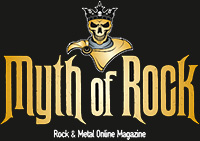Influenced by many metal bands of the 90s and inspired by the old fairytales of their home country, Orkrist, an atmospheric/symphonic/doom/black/folk metal quintet formed in 2000, continues its fantastic journey from Slovakia and offers us a fourth album, “LUEA”. One year has passed since then and Myth of Rock came in contact with the band for an exclusive interview. You can read our nice chat with Peter Gaal (vocals, keyboards) right below!
by Dimitris Zacharopoulos
“LUEA” is your latest album, released in 2023. What inspired the timing of this release?
In 2020 we released the album “Artifacts of Life”, after 17 years. Inspiration for this was to try after such a long time whether we can put together material for an album. Between “Artifacts of Life” and “LUEA” were three years, that is a normal time between two albums.
“LUEA” blends various genres, like black metal, gothic, folk, and atmospheric metal. What is your approach to incorporating these different styles, and how do you maintain a cohesive sound?
To be honest, I have no idea. I like all these styles and diverse bands: Summoning with their fantasy music, old Nightwish with their symphonic heavy style, Cradle of Filth with their gothic black, old Theatre of Tragedy with their romantic doom metal and many others more or less from the same age (90s). All these bands somehow got under my skin and probably therefore can be felt in our music. I think the diversity is not bad, because the albums are not boring after 2-3 songs – at least this is the feedback we get from our fans. But I understand orthodox black metal fans will not find us much attractive, neither pure doom metal fans.
Can you tell us more about the concept behind “LUEA”? Is there a particular story or theme that ties the album together?
“LUEA” is an abbreviation for “Lived Unhappily Ever After”, a kind of opposite of the typical fairytale endings. The album is a combination of various fairytales from our homecountry. Every song is a different tale. And you can find all of them in the graphical cover artwork. If you look closer, you will find witches flying above a mountain, wizard cursing a dragon, a maid jumping from a cliff, and more …. Some of these tales end really sadly.
Orkrist’s music is known for its rich, atmospheric soundscapes. How do you balance these lush, melodic elements with the heavier, more aggressive aspects of your music?
We pay attention to these main elements: atmosphere (by using various keyboard sounds, samples), melodies (we want people to enjoy the music, and not get disharmonies and empty parts of songs just to fill the time) and contrast (softness versus hardness, nice female voice versus hard male vocals, romantic passages versus harder blasts). Again, hard to say how this is made. This is somehow coming automatically when composing.
How has Orkrist evolved musically and thematically since your early albums? What would you say are the key differences between your earlier work and “LUEA”?
There is no such a radical difference. It is always about the attributes I mentioned in the previous answer. But I think the new songs are more sophisticated, while the early songs were easier and maybe more straight forward. As well we are trying to incorporate some new elements – new sounds or instruments e.g. acoustic guitar, timpani hits.
What role does Slovakian culture or folklore play in your music, if any? Are there specific stories or traditions that influence your songwriting?
Slovak folklore has multiple areas – architecture/paintings, old folk songs/ dances, costumes, handicraft and old fairytales. We take only the lastly listed element. We have more bands which try to incorporate the old folk graphical designs, use some costumes and make maybe the visual experience closer to our folk. But we feel it like this, as we are not singing in our own language and prefer universal English.
The instrumentation on “LUEA” feels complex and multi-layered. Can you walk us through your writing process? Do you start with a riff, a melody or perhaps a conceptual idea?
So far the music was composed by me on a keyboard. I would not be able to say it starts always with a specific instrument, however normally it is some keyboard idea, where I add drums, some easy guitar sounds. Many times the song evolves in a way that I leave the main idea and continue with drums only, or flute. Then the rest instruments come. In the future I plan to work with my band mates in a way that an idea comes from a guitar melody or female voice idea.

The production on “LUEA” has a distinctive rawness to it, which gives the album a unique character. Was this a deliberate choice? How important is production in shaping the sound of your music?
We are an underground band and have limited possibilities because of finances. We cannot simply go to studio for three weeks, ask a world-known producer for mastering. We have limited budget and need to be carefully where to invest that. Last time it went to our first official video clip, while the album was from main part home-made. All the instruments were recorded into my computer where I played with the sound. We got some professional help only with the final mix and mastering, and that from a friend rather than a known metal music producer.
Orkrist is known for defying genre boundaries. How do you view the concept of genre in metal today? Do you feel it’s limiting or liberating as an artist?
The world has changed. And to be honest our style is not that attractive as it was twenty years ago. At that time people were surprised by seeing keyboards, flute or female voice. Nowadays I observe the world is interested into visual footprint of the band (you need to have original costumes, show, scene, painting, …) and a kind of extreme music direction (screaming female singer, brutality, brutal death ….). And lot of the success is created in the virtual world – where you don’t need to have a kind of interesting music, but by investing into high quality production of visual media you can make a stronger impact.
Lyrically, what themes or messages are you hoping to convey through your songs? Is there a particular song on “LUEA” that holds special meaning for you?
All the songs are based on themes coming from old fairytales, as mentioned before. An example (“Prince of Melancholy”, feel free to watch our video clip on YouTube) is about love of a young lord to a farmer’s daughter, what was in the old world not possible. Even they both love each other, the young lord’s father has a clear plan to marry him to a lady from another castle. Once the young lord has his wedding, the farmer’s daughter sees that in the window of the castle and jumps from a cliff because of her sadness.
Given the wide range of musical influences in your sound, what are some of the key artists or bands that have inspired you over the years?
I don’t look that much at the sound and focus more on the content of the music. Regarding inspiration there I mentioned already some bands from the 90’ies and worth to mention definitely: Summoning, Bal Sagoth, Mystic Circle, Cradle of Filth, Nightwish, Theatre of Tragedy, Evol, Haggard, ….
What do you want listeners to take away from their experience with “LUEA”? Is there a particular emotion or state of mind you aim to evoke with your music?
We want (as with all our albums) that our fans enjoy the atmosphere. Do not expect virtuosity of individual instruments or admiring some specific part, neither top production, frequent rhythm changes or some disharmonies. Imagine a pretty simple straight forward music with easy melodies and vocal lines, switching between faster black metal sounded sections to slower doom metal melodies, some heavy guitar lines in between.
The metal scene in Slovakia may not be as globally recognized as some other countries. How do you see the Slovakian metal scene, and has it influenced your music in any way?
We are a small country, but have pretty diverse scene with mixture of many styles – from brutal death metal to orthodox black metal (there are even bands under world known labels like Osmose Prod), orthodox doom metal, symphonic female/heavy bands, progressive bands, gothic, pagan black. We have bands which play already centuries and still are there, perceived as local legends, but as well new younger bands coming and trying to bring new wave. These new rely more on virtual promotion while the old bands benefit from larger quantity of people, when playing live. If I would mention one successful band abroad, it would be probably Malokarpatan or Krolok.
Are there any plans to tour in support of “LUEA”? What can fans expect from an Orkrist live performance today compared to previous years?
There is not a plan for tour, we are a small band playing mainly single shows in Slovakia, something in Czech republic, maybe Hungary. And we always perform songs from all our four albums, not just the latest one. Our fans demand some classic songs from our past. Currently we are trying to make our show more attractive – some visuals, light elements, costumes.
After the release of “LUEA”, what’s next for Orkrist? Are you already working on new material, or do you have other creative projects in mind for the near future?
We are working slowly on the new album. The music is composed and we just need to record individual instruments, mix the tracks, do the graphics and start the promo. This is the plan for 2025.

